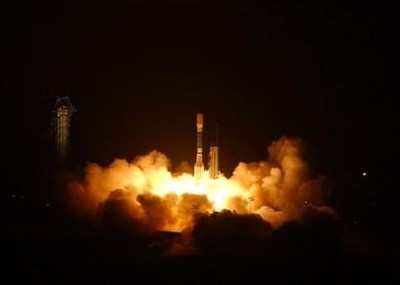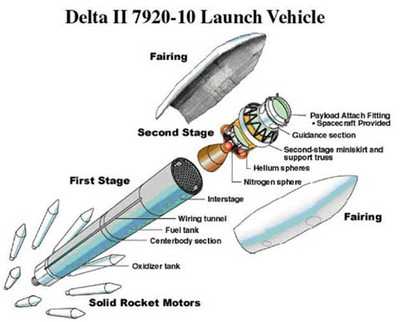So Far, So Good
Activation of the Aura spacecraft, launched July 15, is
continuing, with the mission going very well so far.

Just over an hour after launch, the spacecraft separated from
the Boeing Delta II launch vehicle. This was followed shortly
thereafter by deployment of the spacecraft's solar array and
transition to Sun point mode. The next day, the spacecraft
transitioned to Earth point mode, where it remained another day
before transitioning to fine point mode, the mission's normal
operating mode. S-band communications with the space network began
immediately, followed by routine ground network contacts. X-band
playbacks from the solid-state recorder to the ground network are
now ongoing as well.
All spacecraft subsystems have demonstrated readiness to support
science operations, which cannot begin until the instruments are
fully activated and Aura has reached its nominal orbit
altitude.
With respect to orbit altitude, four of six planned ascent burns
have been completed. The fifth ascent burn is planned for Fri.,
August 6. The Aura ascent plan anticipates reaching a nominal
altitude of 705 kilometers (about 438 miles) this month.
All four instruments are powered and are systematically being
activated; the following are some of the highlights that have
occurred so far. The antenna launch latch for the Microwave Limb
Sounder primary reflector has been released, and the receivers are
undergoing characterization activities. Good output power from the
Microwave Limb Sounder THz module gas laser local oscillator has
been confirmed. The Tropospheric Emission Spectrometer translator
has been unlatched, as has that instrument's pointing control
system gimbals. The Sun-shield door for the High Resolution
Dynamics Limb Sounder has been released. Transition of the
Tropospheric Emission Spectrometer, High Resolution Dynamics Limb
Sounder and the Ozone Monitoring Instrument to science mode is
paced by their significant outgassing requirements, which last
about 30 days.
"From what we have seen so far, satellite performance appears
very solid," said Rick Pickering, Aura project manager at NASA's
Goddard Space Flight Center, Greenbelt (MD). "Also, the performance
of the entire operations team has been tremendous. Not only are all
the team members inherently sharp and well-trained, many of them
have extensive experience with Aqua, which is paying great
dividends."

Aura, a mission dedicated to the health of Earth's atmosphere,
will help us understand and protect the air we breathe. Aura will
help answer three key scientific questions: Is Earth's protective
ozone layer recovering? What are the processes controlling air
quality? How is Earth's climate changing? NASA expects early
scientific data from Aura within 30 to 90 days.
Each of Aura's four instruments is designed to survey different
aspects of Earth's atmosphere. Aura will survey the atmosphere from
the troposphere, where mankind lives, through the stratosphere,
where the ozone layer resides and protects life on Earth.
With the launch of Aura, the first series of NASA's Earth
Observing System satellites is complete. The other satellites are
Terra, which monitors land, and Aqua, which observes Earth's water
cycle.
The High Resolution Dynamics Limb Sounder was built by the
United Kingdom and the United States. NASA's Jet Propulsion
Laboratory, developed and manages the Microwave Limb Sounder and
Tropospheric Emission Spectrometer. The Ozone Monitoring Instrument
was built by the Netherlands and Finland in collaboration with
NASA. NASA's Goddard Space Flight Center manages the Aura
mission.
The Microwave Limb Sounder is intended to improve our
understanding of ozone in Earth's stratosphere, which is vital in
protecting us from solar ultraviolet radiation. The Tropospheric
Emission Spectrometer is an infrared sensor designed to study
Earth's troposphere and to look at ozone and other urban
pollutants.
 Airbus Racer Helicopter Demonstrator First Flight Part of Clean Sky 2 Initiative
Airbus Racer Helicopter Demonstrator First Flight Part of Clean Sky 2 Initiative Diamond's Electric DA40 Finds Fans at Dübendorf
Diamond's Electric DA40 Finds Fans at Dübendorf ANN's Daily Aero-Term (04.23.24): Line Up And Wait (LUAW)
ANN's Daily Aero-Term (04.23.24): Line Up And Wait (LUAW) NTSB Final Report: Extra Flugzeugbau GMBH EA300/L
NTSB Final Report: Extra Flugzeugbau GMBH EA300/L Classic Aero-TV: 'Never Give Up' - Advice From Two of FedEx's Female Captains
Classic Aero-TV: 'Never Give Up' - Advice From Two of FedEx's Female Captains




